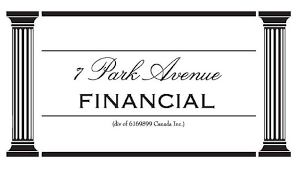|
The Hidden Financing Solution: Account Receivable Finance for Growing Businesses
The Cash Flow Crisis Killer: How Account Receivable Finance Saves Businesses
YOUR COMPANY IS LOOKING FOR BUSINESS FINANCE SOLUTIONS!
Canadian Business Financing: Breaking Down Account Receivable Factoring
UPDATED 07/13/2025
You've arrived at the right address! Welcome to 7 Park Avenue Financial
Financing & Cash flow are the biggest issues facing businesses today
ARE YOU UNAWARE OR DISSATISFIED WITH YOUR CURRENT BUSINESS FINANCING OPTIONS?
CONTACT US:
7 Park Avenue Financial
South Sheridan Executive Centre
2910 South Sheridan Way
Oakville, Ontario
L6J 7J8
Direct Line = 416 319 5769
Email = sprokop@7parkavenuefinancial.com

Account Receivable Financing: Unlocking Small Business Potential in Canada
Introduction
Account receivable financing, also known as invoice financing, has taken Canada by storm, not just among small businesses but also among the nation's corporate giants who use similar funding.
The question arises: what is causing this surge in popularity? This article delves deep into this financing solution, highlighting its benefits and mechanisms especially tailored to the Canadian business context for financing outstanding invoices.
The Cash Flow Crisis Every Business Owner Faces
Your accounts payable / invoices are outstanding, but your bills aren't waiting.
Traditional financing feels impossible with strict requirements and lengthy approval processes. Meanwhile, your business suffers from cash flow strangulation, forcing you to turn away opportunities or struggle with operational expenses.
Let the 7 Park Avenue Financial team show you how Account receivable finance on money owed to your business transforms your unpaid invoices into immediate capital, solving cash flow problems without adding debt on the company's balance sheet.
The Need to Finance Current Assets
Every astute business owner or financial manager understands the implications of holding investments in assets like accounts receivable AR and inventory.
These so-called current assets undeniably require some form of financing. While it's an option to self-finance—that is, wait patiently for inventory to transform into receivables and eventually cash—this route can stymie growth potential and even challenge a company's financial stability.
After all, isn't it universally acknowledged that cash flow reigns supreme?
The Power of A/R Collateral in Financing
Those acquainted with Canadian chartered banking are no strangers to the term collateral. But why not turn the tables and employ your company's innate collateral, primarily accounts receivable, to harness cash?
This approach, often called account receivable financing, invoice discounting, or factoring, holds the key to unearthing locked cash flow.
The Mechanics of Account Receivable Financing: How Does Accounts Receivable Financing Work?
Setting up an account receivable financing facility is straightforward. Once operational, it's arguably one of the most swift and effortless mechanisms to unleash cash flow and bolster working capital, be it daily, weekly, or monthly.
The steering wheel remains firmly in your grip, ensuring you finance only what's needed.
Delving deeper, there are primarily two types of factoring in Canada.
For simplicity's sake, let's spotlight the predominant one. The process is as follows: once an invoice is raised, it's presented to your factoring company.
This could range from a single invoice to multiple ones. Funds corresponding to these unpaid invoices are promptly transferred to your account, ushering in a renewed cash flow stream.
While about 10 percent is retained as a safeguard, it is eventually released upon client payment, minus a nominal discount fee, usually hovering between 1 and 1.5 percent.
Companies choosing to bill and collect their invoices while receiving all the benefits of A/R financing should select receivable confidential finance. Click here for more information on non notification confidential A/R finance .
Benefits of Accounts Receivable Financing
Accounts receivable financing offers fast approvals and access to funds via the receivable financing application.
No need for external collateral or guarantees exists. Streamlined application with limited paperwork is required.
Absence of binding long-term contracts enhances flexibility. It enhances cash flow and simplifies financial planning for upcoming business expenses. The system offers flexibility in deciding financing timing and amount.
Debunking the Cost Misconception
A 0.75–1.5 percent fee might appear steep, particularly for small businesses, compared to a bank line of credit. However, a holistic view reveals a different picture.
When the accumulated costs associated with traditional banking—including various fees and service charges—are accounted for, the scales might tip in favor of factoring.
The newfound liquidity can also be channeled for strategic advantages, seizing early payment discounts or outpacing competitors.
Conclusion
While myriad financing avenues dot the landscape, account receivable financing and receivable loans are formidable contenders, especially for firms grappling with the cash flow problem posed by A/R assets.
Call 7 Park Avenue Financial, a trusted, credible, and experienced Canadian business financing advisor, an expert in small business financing in Canada. Remember, in business, staying informed translates to staying ahead.
Case Study: The Benefits of Account Receivable Finance
Company: Mid-sized IT consulting firm in Toronto
Challenge: Growing rapidly but struggling with 60-day payment terms from enterprise clients, creating cash flow gaps that prevented taking on new projects.
Solution: Implemented account receivable finance to convert outstanding invoices into immediate working capital.
Results:
- Improved cash flow by 80% within 30 days
- Increased project capacity by 40% without additional borrowing
- Reduced administrative burden through professional credit management
- Enhanced customer relationships by offering more flexible payment terms
- Achieved 25% revenue growth in the first year
Key Takeaway: Account receivable finance transformed a growing company's cash flow constraints into competitive advantages, enabling sustainable growth without traditional financing limitations.
KEY TAKEAWAYS
-
Invoice Conversion Process: Understanding how unpaid invoices transform into immediate cash through factoring arrangements provides the foundation for all account receivable finance decisions.
-
Customer Credit Assessment: Recognizing that financing approval depends on your customers' creditworthiness/customer payments rather than your business credit eliminates common qualification misconceptions.
-
Recourse vs. Non-Recourse Structure: Distinguishing between these two fundamental arrangements determines your risk exposure and cost structure in factoring relationships.
-
Advance Rate Calculation: Knowing that most providers advance 70-90% of invoice value immediately helps businesses plan cash flow and understand available funding levels.
-
Cost Structure Analysis: Understanding that factoring fees typically range from 1-2% monthly based on customer credit and payment terms/accounts receivable turnover ratio enables accurate cost comparisons when you evaluate accounts receivable funding solutions.
-
Growth Scalability Feature: Recognizing that financing capacity increases automatically with sales volume differentiates account receivable finance from fixed traditional loans.
-
Cash Flow Timing Benefits: Appreciating that factoring eliminates the 30-90 day payment wait provides the primary value proposition for most businesses.
-
Industry Application Flexibility: Understanding that account receivable finance works across most B2B industries expands consideration beyond traditional lending restrictions.
FAQ
What is account receivable financing?
Account receivable financing, also known as invoice discounting or factoring, is a method where businesses can turn their pending invoices into immediate cash by selling them to a third party, known as a factor. Accounts receivable financing allows companies to secure loans against their pending invoices. This dynamic mechanism aids enterprises of all sizes in sidestepping cash flow hurdles and equipping them with the means to drive business expansion.
The accounts receivable financing application can be approved in a matter of days. Business owners find that applying for accounts receivable funding is much more streamlined than other financing and business loan solutions.
How can this type of financing benefit Canadian small businesses?
Accounts receivable financing works because it provides immediate liquidity, bolsters cash flow, helps manage outstanding receivables, and allows businesses to capitalize on growth opportunities without waiting for traditional payment cycles.
Isn't a 1-2% percent fee expensive for small businesses?
At first glance, it might seem so. However, funding via receivable financing companies can prove cost-effective compared to the hidden costs associated with traditional banking. The swift liquidity can be strategically channeled via accounts receivable financing companies for further advantages.
Can any business opt for account receivable financing?
While it's primarily tailored for businesses with significant A/R assets, most firms that generate invoices and face cash flow delays can benefit from this type of financing.
How does this differ from a traditional loan or credit?
Unlike a traditional accounts receivable loan or credit line that depends on a business's creditworthiness, AR financing is based on the quality of the receivables. It allows companies to get access to cash without incurring debt.
How is the creditworthiness of my clients evaluated in account receivable financing?
In account receivable financing, the creditworthiness of your clients is paramount. The accounts receivable financing company will evaluate your clients' payment history, financial health, and reputation. If your clients have a solid track record of paying invoices on time, you're more likely to receive favorable terms for accounts receivable loans.
Are there industries or sectors where accounts receivable factoring and financing are more prevalent?
A/R financing is versatile and can be employed across various sectors. However, it's particularly popular in industries with long invoice cycles, like manufacturing, wholesale, staffing agencies, and transportation. Any business with extended payment terms can benefit from this method.
What's the difference in invoice factoring between recourse and nonrecourse accounts receivables financing?
In recourse financing, if the factor cannot collect on an invoice, the business is responsible for buying back the invoice or replacing it with a viable alternative. In nonrecourse financing, the factor assumes the risk of nonpayment, but often at a higher fee.
Can startups or new businesses avail of account receivable financing if bank financing is unavailable?
Yes, startups and newer businesses can leverage cash flow via an account receivable financing agreement. Factors often emphasize the quality and reliability of your clients over the length of your business operations. Due to a short credit history, it can be a boon for new businesses struggling to obtain traditional financing.
The difference between factoring and accounts receivable financing is that factoring involves the sale of accounts receivables via a factoring agreement. A factoring loan arrangement with a financing company specifies the sale of accounts receivable in exchange for an advance of funds on unpaid invoices—in traditional "old school" factoring, the financing company becomes responsible for collecting outstanding invoices. Many companies and businesses blur the lines between accounts receivable factoring and financing.
How does account receivable financing affect my business relations with clients?
When small business owners engage in account receivable financing, the invoice factoring company takes over the invoice collection process. Choosing a reputable finance firm that employs professional, courteous collection practices is crucial to maintain client relationships. Transparency with clients about the process can also foster trust.
What is an example of accounts receivable finance?
Imagine your small business has outstanding invoices amounting to $20,000 on the balance sheet. You seek an accounts receivable financing company and provide them with these invoices and any required documentation. Based on specific criteria like your industry type and the trustworthiness of your customer, the lender advances you 80 percent of the total invoice value, which is roughly $16,000.
These funds from an account receivable loan can then be used to manage your business costs, including salaries, acquisitions, and rent. A periodic fee, often weekly, is levied by factoring companies until your customer clears the invoice. The payment for the invoice is made directly to the financing company by your client.
After deducting their fees, the finance company remits the balance to the business bank account. Accounts receivable financing frees up the investment companies make in carrying receivables.
What types of businesses benefit most from account receivable finance?
Account receivable finance works exceptionally well for service-based businesses, manufacturers, distributors, and any company with B2B customers who pay on extended terms.
How quickly can I access funds through account receivable finance?
Account receivable finance typically provides funding within 24-48 hours of invoice submission. Once your initial application is approved, subsequent invoices can be funded almost immediately, creating a reliable cash flow stream.
What happens if my customer doesn't pay the invoice?
Account receivable finance comes in two forms: recourse and non-recourse. With recourse factoring, you're responsible if customers don't pay in the accounts receivable process. Non-recourse factoring transfers the credit risk to the factoring company, protecting your business from bad debt.
Are there industry restrictions for account receivable finance?
Account receivable finance is available across most industries, though some sectors like construction, healthcare, and government contracting may have specialized requirements. Each industry presents unique considerations that experienced providers can navigate.
How do costs compare to traditional business loans?
Account receivable finance rates typically range from 1-5% per month, which may seem higher than traditional loans but provides immediate access without lengthy approval processes, collateral requirements, or personal guarantees that banks often demand.
Statistics on Account Receivable Finance
- 82% of businesses that fail cite cash flow problems as a contributing factor
- Account receivable finance can improve cash flow by 75-85% for eligible businesses
- The global factoring market is valued at over $3.2 trillion annually
- 67% of businesses using invoice factoring report improved ability to take on new customers
- Average payment terms for B2B invoices have increased to 47 days in 2024
- Companies using account receivable finance grow 30% faster than those relying solely on traditional financing
Citations
- Canadian Federation of Independent Business. "Cash Flow Challenges for Small Business." CFIB Research Report, 2024. https://www.cfib-fcei.ca
- Statistics Canada. "Business Credit Conditions Survey." Government of Canada, 2024. https://www.statcan.gc.ca
- International Factoring Association. "Global Factoring Market Analysis." IFA Annual Report, 2024. https://www.factoring.org
- Bank of Canada. "Business Financial Conditions Survey." Monetary Policy Report, 2024. https://www.bankofcanada.ca
- TD Economics. "Small Business Financing in Canada." TD Bank Financial Group, 2024. https://www.td.com
- 7 Park Avenue Financial ."Accounts Receivable Financing Invoice Factoring for Canadian Businesses . https://www.7parkavenuefinancial.com/ar-financing-factoring-receivables-finance.html

' Canadian Business Financing With The Intelligent Use Of Experience '
STAN PROKOP
7 Park Avenue Financial/Copyright/2025

ABOUT THE AUTHOR: Stan Prokop is the founder of 7 Park Avenue Financial and a recognized expert on Canadian Business Financing. Since 2004 Stan has helped hundreds of small, medium and large organizations achieve the financing they need to survive and grow. He has decades of credit and lending experience working for firms such as Hewlett Packard / Cable & Wireless / Ashland Oil
|